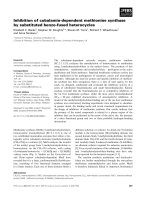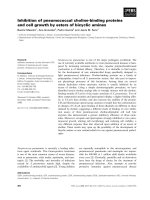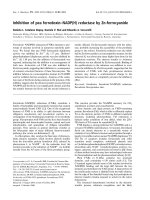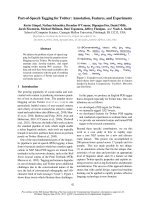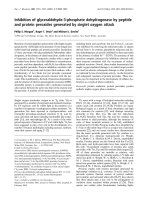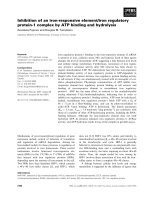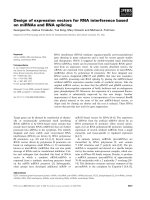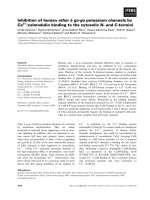Báo cáo khoa học: Inhibition of a-synuclein fibrillization by dopamine analogs via reaction with the amino groups of a-synuclein Implication for dopaminergic neurodegeneration pot
Bạn đang xem bản rút gọn của tài liệu. Xem và tải ngay bản đầy đủ của tài liệu tại đây (522.17 KB, 12 trang )
Inhibition of a-synuclein fibrillization by dopamine analogs
via reaction with the amino groups of a-synuclein
Implication for dopaminergic neurodegeneration
Hong-Tao Li
1
, Dong-Hai Lin
2
, Xiao-Ying Luo
1
, Feng Zhang
3
, Li-Na Ji
1,3
, Hai-Ning Du
1
,
Guo-Qiang Song
2
, Jun Hu
3,4
, Jia-Wei Zhou
1
and Hong-Yu Hu
1
1 Key Laboratory of Proteomics, Institute of Biochemistry and Cell Biology, Shanghai Institutes for Biological Sciences, Chinese Academy of
Sciences, Shanghai, China
2 Shanghai Institute of Materia Medica, Shanghai, China
3 Shanghai Institute of Nuclear Research, Shanghai, China
4 Bio-X Research Center, Shanghai Jiaotong University, Shanghai, China
Parkinson’s disease (PD) is a common movement dis-
order characterized by degeneration of dopaminergic
neurons and deposition of fibrillar Lewy bodies com-
prising primarily a-synuclein (a-Syn) in the substantia
nigra [1–4]. A growing body of evidence strongly
supports the theory that formation of a-Syn fibrils
and dopamine (DA) metabolism are closely associ-
ated with the pathogenesis of this fatal disease [5–7].
These findings imply an intrinsic link between the
presynaptic a-Syn protein and the DA molecule [8],
a synaptic neurotransmitter that functions in signal
transmission. Recent research has focused on oxida-
tive stress in brain, DA metabolism and dysfunction
of a-Syn in synapses, in an attempt to elucidate an
overview linking these important biological processes.
Conway et al. [9] reported that DA stabilized the
a-Syn protofibrils by forming a DA-a-Syn adduct.
They proposed that DA could react with the phenol
Keywords
a-synuclein; dopamine; inhibition;
fibrillization; Parkinson’s disease
Correspondence
H Y. Hu, Institute of Biochemistry and Cell
Biology, Shanghai Institutes for Biological
Sciences, Chinese Academy of Sciences,
320 Yue-yang Road, Shanghai 200031,
P. R. China
Fax: +86 021 54921011
Tel: +86 021 54921121
E-mail:
(Received 28 March 2005, revised 20 May
2005, accepted 25 May 2005)
doi:10.1111/j.1742-4658.2005.04792.x
Fibrillization of a-synuclein (a-Syn) is closely associated with the formation
of Lewy bodies in neurons and dopamine (DA) is a potent inhibitor for
the process, which is implicated in the causative pathogenesis of Parkin-
son’s disease (PD). To elucidate any molecular mechanism that may have
biological relevance, we tested the inhibitory abilities of DA and several
analogs including chemically synthetic and natural polyphenols in vitro.
The MS and NMR characterizations strongly demonstrate that DA and its
analogs inhibit a-Syn fibrillization by a mechanism where the oxidation
products (quinones) of DA analogs react with the amino groups of a-Syn
chain, generating a-Syn–quinone adducts. It is likely that the amino groups
of a-Syn undergo nucleophilic attack on the quinone moiety of DA analogs
to form imino bonds. The covalently cross-linked a-Syn adducts by DA
are primarily large molecular mass oligomers, while those by catechol and
p-benzoquinone (or hydroquinone) are largely monomers or dimers. The
DA quinoprotein retains the same cytotoxicity as the intact a-Syn, suggest-
ing that the oligomeric intermediates are the major elements that are toxic
to the neuronal cells. This finding implies that the reaction of a-Syn with
DA is relevant to the selective dopaminergic loss in PD.
Abbreviations
Ab, amyloid b-protein; AFM, atomic force microscopy; CA, catechol; DA, dopamine; DAQ, dopamine-quinone; EGCG, (–)-epigallocatechin
gallate; GAV, a peptide motif with a homologous sequence of VGGAVVAGV; HQ, hydroquinone; HSQC, heteronuclear single quantum
coherence; MTT, 3-(4,5-dimethylthiazol-2-yl)-2,5-diphenyltetrazolium bromide; NAC, nonamyloid component; NBT, nitroblue tetrazolium
chloride; pNP, p-nitrophenol; PrP, prion protein; pXG, p-xylylene glycol; Q, p-benzoquinone; a-Syn, human a-synuclein; ThT, thioflavin T.
FEBS Journal 272 (2005) 3661–3672 ª 2005 FEBS 3661
groups of tyrosine residues in a-Syn resulting in
dityrosine linkages [10] and stabilize a-Syn oligomers
or protofibrils, which are more toxic than the mature
fibrils to neural cells.
Although the biological function of a-Syn has not
been fully understood, it is characterized by fibrillar
assembling both in vivo and in vitro [2,11,12]. The
protein contains an apolipoprotein-like amphipathic
N-terminus with 5–7 repeats of KTKEGV sequence,
an acidic C-terminus and the so-called nonamyloid
component (NAC) region [13]. The N- and C-terminal
regions are not directly responsible for a-Syn fibrilliza-
tion, whereas the central hydrophobic region is likely
to be the nucleation core [14,15]. We have identified
a novel GAV motif that is essential to fibrillization of
a-Syn as well as other amyloidogenic proteins [16] and
found that the natively unfolded structure of the pro-
tein also plays an important role in the fibrillization
process (unpublished data). Study of inhibition of
fibrillization may provide insight into understanding of
the a-Syn fibrillization (Lewy-body formation) and the
related cytotoxicity (dopaminergic loss). In addition,
research on the fibrillization inhibitors may help us
elucidate the pathogenesis of DA-related neurodegen-
erative diseases and discover potential probes and
drugs for clinical diagnosis and treatment.
We tested DA and some polyphenol analogs and
found that they inhibit a-Syn fibrillization with great
efficacy in vitro. These polyphenols can react with and
covalently modify the a-Syn molecule through linking
to the amino groups of the protein. Cross-linked
dimers or oligomers by DA or other analogs were also
identified and found to be toxic to PC12 cells.
Results
Inhibition of a-Syn fibrillization by dopamine
analogs
In a manner similar to other amyloidogenic proteins,
a-Syn readily aggregates into fibrils in vitro. Under the
conditions of incubation at 37 °C, it normally takes
six days to grow into the regular mature fibrils [16].
The time courses of the fibrillization processes of
a-Syn incubated with the DA-analog compounds were
monitored by a thioflavin (ThT) fluorescence assay
[17]. Figure 1 displays inhibition of a-Syn fibrillization
by catechol-like polyphenols. Hydroquinone (HQ) and
catechol (CA), two diphenol isoforms, significantly
inhibit the fibrillization of a-Syn (Fig. 1B). They can
completely destroy a-Syn fibrillization at a concentra-
tion as low as 50 lm, compared with the protein con-
centration of 200 lm. DA and l-dopa, two natural
structural analogs of catechol, also inhibit a-Syn fibril-
lization with an equimolar amount (Fig. 1C) as repor-
ted previously [9]. p-Nitrophenol (pNP) and ascorbic
acid (vitamin C) are also efficacious inhibitors for the
processes (Fig. 1D). The electron attraction property
of the nitro group in pNP and the conjugated enol
form of vitamin C make them a bit acidic and reactive
to oxidation. Chemically, they are similar to diphenol
compounds. Interestingly, p-benzoquinone (Q), the oxi-
dation product of HQ, can equally suppress the fibrilli-
zation process. We also examined polyphenols isolated
from green tea. The polyphenol mixture also effectively
inhibits a-Syn fibrillization (data not shown), and (–)-
epigallocatechin gallate (EGCG), a major component
of green tea polyphenols, gives an IC
50
of 20 lm .
Moreover, p-xylylene glycol (pXG) was used as a neg-
ative control. It has no inhibiting effect on a-Syn fibril-
lization even at millimolar amounts (Fig. 1E). These
data demonstrate that the inhibition results from spon-
taneous oxidation products of these polyphenols,
rather than from binding of the aromatic rings.
Dopamine-quinone (DAQ) has been reported to
react with a-Syn leading to inhibition of a-Syn fibril-
lization but prolonging the lifetime of the protofibril-
lar intermediates [9]. As revealed by AFM [18], a-Syn
aggregates into abundant regular filaments after incu-
bation for six days. However, in the presence of
inhibitors such as HQ and DA during the incubation
process, a-Syn fails to form regular fibrils. Only small
oligomers are visualized dispersing in the images
(Fig. 1F). This observation demonstrates that DA
analogs inhibit formation of a-Syn fibrils but stabilize
the oligomers or protofibrils in the intermediate
states.
Reactions of a-Syn with quinones
Polyphenols can be spontaneously oxidized into qui-
nones by dissolved oxygen in the buffer at atmo-
sphere. Reactions of these quinones with a-Syn result
in the increases of absorbance at 280 nm and 345 nm
in the UV spectra (see below). Under inhibitory con-
ditions, the oxidation products of polyphenols (CA,
HQ and Q) reacting with a-Syn show the increase of
UV absorption in the position of residual monomeric
forms in size-exclusion chromatography (SEC) profile
(Fig. 2A), suggesting that these fractions are gener-
ated by cross-linking of a-Syn with the quinones [9].
From the UV absorption of SEC profile, it is suggest-
ive that the reaction of Q or HQ with a-Syn gives
rise to high amount of monomeric adducts. Besides
the monomers, the reaction products also contain
fractions with larger molecular masses, mostly in
Reaction of a-synuclein with dopamine analogs H T. Li et al.
3662 FEBS Journal 272 (2005) 3661–3672 ª 2005 FEBS
dimeric and trimeric forms. Intriguingly, DA quinone
reacts with a-Syn to generate large molecular mass
fractions, mostly oligomers or protofibrils. SDS ⁄
PAGE analysis of the fractions from the SEC profiles
reveals a molecular ladder of oligomeric forms
(Fig. 2B). The reaction product of DAQ contains
large amount of oligomers, while those of other qui-
nones are mainly dimers and slightly trimers. These
oligomers are cross-linked species as they are resistant
to dissociation by SDS and 8 m urea (Fig. 2C). MS
analysis of the oligomeric fraction from the Q reac-
tion product also reveals a large amount of a-Syn-
adduct dimers (Fig. 2D), in which one protein dimer
may attach several quinones to give a molecular mass
mixture (the r.m.m. of a-Syn dimer is 28 920 Da).
These observations suggest that the quinones react
with a-Syn to generate quinone adducts and cross-
linked dimers or oligomers.
Quinones are cross-linking to a-Syn
To ascertain that these DA analogs are cross-linking
to a-Syn, we determined the molecular masses of the
monomeric forms from the reaction products by ESI-
MS (Fig. 3). The monomeric fraction of the reaction
products shows a bundle of peaks with different
molecular masses, while the intact a-Syn gives a major
peak with a molecular mass of 14 458 Da. Table 1 dis-
plays the molecular masses and the proposed pattern
of the monomeric adducts by these reactions. Reaction
of a-Syn with these DA analogs gives a group of
adducts with molecular masses larger than intact
a-Syn (expectedly 14 460 Da). For the Q reaction, the
additional mass is an exact multiple of 104 (104 n)
Daltons, which is in agreement with the molecular
mass of the Q individual after reaction with two active
groups (108–2 · 2 Da). The patterns for the incremen-
400 nm 400 nm
400 nm
A
BC
D
F
E
Fig. 1. Inhibition of a-Syn fibrillization by
polyphenols. (A) Structures of the com-
pounds. HQ, hydroquinone; CA, catechol;
Q, p-benzoquinone; pXG, p-xylylene glycol;
pNP, p-nitrophenol; DA, dopamine; VC, vita-
min C. (B) HQ and CA in different concen-
trations. (C) DA and
L-dopa. (D) Q, VC and
pNP. (E) pXG. The mixtures of a-Syn and
the compounds were incubated for several
days, and then the fibrillization at different
intervals was measured by ThT fluorescence
assay. The concentration of a-Syn was
200 l
M and the fibrillization of a-Syn alone
was as a comparison. Data were represen-
ted as means ± SEM. (F) Atomic force
microscopic images of a-Syn fibrils. a-Syn
(200 l
M) was incubated with 200 lM of HQ
(middle) or DA (right) for 6 days. The a-Syn
alone sample was as a control (left). All
graphs are topographical height images of
2 lm
2
in area and the scale bar represents
400 nm.
H T. Li et al. Reaction of a-synuclein with dopamine analogs
FEBS Journal 272 (2005) 3661–3672 ª 2005 FEBS 3663
tal masses for the reactions of HQ and CA can also be
expressed as 104 n +16 m (where n and m are inte-
gers, normally n £ 6, m £ 4). The additional molecular
mass of 16 Da implies that the protein has been oxi-
dized by reactive oxygen species generated by auto-
oxidation of the polyphenols during incubation
process. The most likely sites for the oxidation are
within the methionine residues, where oxygen atoms
easily adduct to the thioether groups to be sulfoxides
[19]. a-Syn
1)60
, the nonamyloidogenic variant of
a-Syn, can also react with Q, resulting in the products
with additional mass of multiple 104 Da. From Fig. 3
and Table 1, we found that the predominant reaction
products of Q or HQ are a-Syn-Q adducts, while those
of CA are mainly methionine oxidized a-Syn with
small amount of a-Syn-CA adducts. This observation
is consistent with the UV absorption enhancement
in SEC profiles (Fig. 2A). Unexpectedly, we failed to
detect the DA adduct in the monomeric form by
mass spectrometry. To confirm that reaction of DA
B
D
C
A
Fig. 2. Cross-linked oligomerization of a-Syn by DA analogs. (A) SEC analysis of the reaction products showing the large molecular mass
fractions. The graphs display incubation of a-Syn alone (black), the reactions of a-Syn with DA (red), CA (green), HQ (purple) and Q (blue),
respectively. a-Syn (200 l
M) was incubated with 1 mM of DA analogs for 24 h, and then the reaction mixtures were analyzed by means of
SEC. (B) SDS ⁄ PAGE graph of the fractions from SEC separation of the reaction products of a-Syn with Q (up) or DA (down). The fractions
collected from the elution profile at around 19 min and 23 min are dominantly oligomers and dimers, respectively. Samples were loaded on
an SDS ⁄ PAGE (15% polyacrylamide gel) with silver staining. Mr, molecular mass marker; M, monomer; D, dimer; T, trimer; O, oligomer. (C)
SDS ⁄ PAGE graph of the reaction products from a-Syn (200 l
M) with 1 mM of DA analogs showing the covalently modified adducts. The
reaction mixtures were dissolved in a loading buffer with (right lane) or without (left lane) 8
M urea. An equal amount of the proteins was loa-
ded in each lane of the gel. The a-Syn alone sample incubated for 1 day was also subjected to SDS ⁄ PAGE as a control, which shows no
dimer or oligomer in the gel. (D) MALDI-TOF MS spectrum of the large molecular mass fraction from the reaction of a-Syn with p-benzo-
quinone. The sample was isolated from the reaction mixture by SEC. The small peaks (M) with molecular masses around 15 kDa are the
contaminants of monomeric form in the dimeric fraction. M: monomer, r.m.m. of 14 460 Da; D: dimer, r.m.m. of 28 920 Da. The peaks
with larger molecular masses indicate different species of a-Syn–quinone adducts.
Reaction of a-synuclein with dopamine analogs H T. Li et al.
3664 FEBS Journal 272 (2005) 3661–3672 ª 2005 FEBS
with a-Syn produces mostly large molecular mass
adducts, we performed SDS⁄ PAGE analysis by redox-
cycling staining [20] for detecting quinoproteins
(Fig. 4). The quinoproteins of the DA-adduct are
largely involved in the oligomeric forms, while those
of other products (Q-, HQ- or CA-adduct) are in
monomeric and dimeric forms. This is in good agree-
ment with the result from Coomassie Blue staining for
protein bands. The results suggest that DA attach to
a-Syn chain through DAQ, leading to formation of
the oligomeric adducts while other analogs form
quinoproteins in monomeric or dimeric form.
Fig. 3. Electrospray MS analysis of the
monomeric a-Syn–quinone adducts. The
reaction mixture of a-Syn (200 l
M)and
3m
M of Q (middle) or 5 mM of HQ (right)
was incubated for 24 h and the monomeric
fraction was isolated by SEC for MS analy-
sis. The MS graph of fresh a-Syn was as a
control (left).
Table 1. Molecular masses of the monomeric adducts as determined by electrospray mass spectrometry. Molecular masses were of the
peaks detected by ESI-MS. Pattern shows incremental molecular masses of the reaction products.
Reaction Molecular masses (Da) Pattern
a-Syn
1)60
6189.5 ¼ 6188.2 +1.3 6188.2
a-Syn
1)60
+ Q, 1 h 6189.5 ¼ 6188.2 +1.3; 6293.3 ¼ 6188.2 +104 +1.1; 6188.2 + 104 n
6396.8 ¼ 6188.2 +208 +0.4; 6499.5 ¼ 6188.2 +312–0.7;
a-Syn 14 458 ¼ 14 460–2 14 460
a-Syn + Q, 1 h 14 565.5 ¼ 14 460 +104 +1.5; 14 668.8 ¼ 14 460 +208 +0.8; 14 460 + 104 n
14 764.0
a-Syn+ Q, 24 h 14 563.8 ¼ 14 460 +104–0.2; 14 668.5 ¼ 14 460 +208 +0.5; 14 460 + 104 n
14 772.8 ¼ 14 460 +312 +0.8
a-Syn + HQ, 24 h 14 562 ¼ 14 460 +104–2; 14 580 ¼ 14 460 +104 +16; 14 460 + 16 m + 104 n
14 666 ¼ 14 460 +208–2; 14 682 ¼ 14 460 +208 +16–2
14 787 ¼ 14 460 +312 +16–1; 14 800 ¼ 14460 +312 +32–4;
14 823 ¼ 14 460 +312 +48 +3; 14 909 ¼ 14460 +416 +32 +1;
15 043 ¼ 14 460 +520 +32 +1
a-Syn + CA, 24 h 14 477 ¼ 14 460 +16 +1; 14 490 ¼ 14 460 +32–2; 14 460 + 16 m + 104 n
14 507 ¼ 14 460 +48–1; 14 734 ¼ 14 460 +208 +48 +2;
14 804 ¼ 14 460 +312 +32; 14 993 ¼ 14 460 +520 +16–3;
15 119 ¼ 14460 +624 +32 +3
a-Syn + DA, 96 h 14 491 ¼ 14 460 +32–1
a
14 460+16 m
a
No DA-adduct was detected in the monomeric form.
H T. Li et al. Reaction of a-synuclein with dopamine analogs
FEBS Journal 272 (2005) 3661–3672 ª 2005 FEBS 3665
Quinone linkage through amino groups of a-Syn
The possible reactive sites for reaction with Q in a pro-
tein chain are the side chains of Cys, Tyr, Lys and
Met residues [21]. a-Syn contains no Cys residue; the
Tyr residues are presumably reported to be the most
potent candidates for the reaction [9]. The molecular
masses of the reaction adducts with the increase of
multiple 16 suggest that Met residues are the oxidation
sites for oxygen. We compared the aromatic region
(6.0–8.0 p.p.m.) of
1
H-
1
H COSY spectra of the intact
and quinone-modified a-Syn (data not shown). The
result shows that the phenol groups of Tyr residues
are unlikely to be the Q linkage sites, because no
chemical-shift disturbance occurs in the aromatic
region. Mutation of tyrosine to phenylalanine also sug-
gested that the tyrosine residues are not required for
protein cross-linking [22].
Quinones readily react with a-Syn generating two
absorption peaks at 280 nm and 345 nm in the UV
spectra (Fig. 5A). Our experiments show that Q can
also react with a-amino group of Gly, Tyr or Lys, but
not with N-acetylglycine, producing a large absorption
peak at 345 nm (Fig. 5B). Instead, reaction of a-Syn
with DA generates a broad shoulder around 345 nm
in the UV spectra (Figs 5C,D). It is likely that DAQ
reacts with the amino group of DA molecule resulting
in formation of melanin that also contributes to the
spectra [23]. These results suggest that the quinone
molecule reacts with a-Syn by attaching to the e-amino
groups of Lys residues or the a-amino group in the
protein N-terminus. To confirm this, we performed
1
H-
15
N HSQC spectra in an
15
N-labeled a-Syn sample.
The chemical shifts of amides in intact a-Syn exhibit
small dispersion in the
1
H dimension, suggesting that
a-Syn is natively unstructured. No peak appeared in
the HSQC spectrum for the e-amino groups of Lys
residues due to the fast exchange with solvent. When
a-Syn reacts with Q (Fig. 6A) or DA (Fig. 6B), three
additional peaks emerge in the 7.7–8.0 p.p.m. region
(
1
H dimension) as compared with that of intact a-Syn.
This suggests that at least three amino groups of an
a-Syn molecule are modified by Q or DA to generate
imino groups that link to the aromatic ring of quinone
and the side chains of the protein. The NMR experi-
ments provide convincing evidence in support of the
reaction between amino groups of Lys residues and Q
or DAQ (the oxidation product of DA). As there are
16 amino groups (15 Lys, one a-amino group) in an
a-Syn molecule, it is worthy of identifying the three to
four reactive Lys residues in a-Syn.
DA linkage retains the cytotoxicity of a-Syn
The previous studies have shown that a-Syn fibrilliza-
tion is toxic to neural cells [5,16]. We examined the
effect of DA-modified a-Syn on cultured PC12 cells
by MTT assay [24]. Figure 7 shows the percentage of
MTT reduction in cell cultures vs. the incubation time.
The incubated a-Syn sample has a significant impact
on the cell viability. It seems that 2-day incubated
a-Syn is more toxic to the cells than the fresh sample
or the samples after incubation for 4–6 days. This sug-
gests that prolonging of incubation may decrease the
amount of oligomeric intermediates and prompt for-
mation of the mature fibrils that may have less toxi-
city. DA alone has a small effect on the cell viability
as reported previously [25]. In a manner similar to
A
B
Fig. 4. Redox-cycling staining of quinone-modified a-Syn. a-Syn (200 lM) was incubated alone (control) or with 1 mM of DA, CA, HQ or Q at
37 °C for 24 h then subjected to SDS ⁄ PAGE (15% polyacrylamide gel). (A) Redox-cycling staining for quinoproteins. (B) Coomassie Blue
staining for proteins. The a-Syn protein (control) cannot be stained with quinone-specific reagent while it can with Coomassie Blue staining.
Mr, molecular mass marker; M, monomer; D, dimer; T, trimer; O, oligomer.
Reaction of a-synuclein with dopamine analogs H T. Li et al.
3666 FEBS Journal 272 (2005) 3661–3672 ª 2005 FEBS
intact a-Syn, the DA-modified sample also presents
significant effect on the cell viability. Similarly, after
removal of excess DA, the DA-modified protein
(mixture of monomer and oligomer), also retains the
cytotoxicity, supporting the hypothesis that the cyto-
toxicity primarily arises from the reaction adduct or
the a-Syn oligomers rather than from free DA or the
a-Syn fibrils. Although DA modification inhibits a-Syn
fibrillization, the MTT reduction experiment suggests
that DA-modified a-Syn has significant cytotoxicity on
PC12 cells. We also isolated the monomeric form of
DA-modified a-Syn by SEC and examined its cyto-
toxicity. The result shows that the monomeric form of
DA-modified a-Syn product exerts a slightly toxic
effect on PC12 cells (Fig. 7B). This implies that the
oligomeric fraction may be the major element that cau-
ses the cytotoxicity. Reaction with DA inhibits a-Syn
fibrillization but stabilizes the oligomers, which retains
the cytotoxicity.
Discussion
Many compounds that inhibit protein amyloidogenesis
are the derivatives of CA or HQ, such as DA [9,26]
and flavonoid [27] for a-Syn, apomorphine [28] and rif-
ampicin [29] for amyloid b protein, and anthracycline
analogs for prion protein [30] and other amyloid fibrils
[31]. DA and other polyphenols are natural com-
pounds that are readily oxidized to quinone forms
when exposed to an oxygen atmosphere. Interestingly,
vitamin C (a biological antioxidant) and EGCG (a
green tea polyphenol of antioxidant role) are also
effective inhibitors for the a-Syn fibrillization. Unlike
DA, CA and Q (or HQ) can inhibit a-Syn fibrillization
Fig. 5. Spectrophotometric characterization of the reactions of DA analogs with a-Syn and some amino acids. (A) UV-vis spectra of a-Syn
with DA, CA, HQ and Q after reaction for 24 h. The a-Syn alone sample was as a control. The concentration of a-Syn was 200 l
M and that
of the compounds was 1 m
M. (B) Time courses of the reactions of Q with a-Syn (circle) and some amino acids as recorded at 345 nm. The
amino acids are Gly (m), Lys (
), Tyr (.) and N-acetylglycine (r), respectively. The Q-alone sample (w) was used as a control. The concen-
tration was 4 m
M for Q, 200 lM for a-Syn and 2 mM for different amino acids. (C) Absorption spectra of a-Syn (200 lM) reacting with DA
(2 m
M). The absorbance at 345 nm increases with the incubation time (0–24 h). (D) Time course of the reaction of a-Syn (200 lM) with DA
(2 m
M)(d) as recorded at 345 nm. The DA alone sample ( ) was used as a control.
H T. Li et al. Reaction of a-synuclein with dopamine analogs
FEBS Journal 272 (2005) 3661–3672 ª 2005 FEBS 3667
with great efficacy, generating mostly monomers or
dimers but not large molecular mass oligomers. Based
on the novel reaction and the inhibitory feature of
quinone moiety, chemically synthetic small compounds
may be applicable to the development of potential
probes for monitoring the fibrillization processes of
Fig. 7. Cytotoxicity of DA-modified a-Syn. (A) Time course of the MTT reduction of different a-Syn forms. The mixture of a-Syn and DA in
different incubation time was performed on cytotoxicity assay on PC12 cells (Syn + DA). To exclude the possibility that DA affects the
assay, excess DA was removed from the protein mixture by desalting column (del DA). Normally, equal molar of DA (300 l
M) was used for
the incubation. The percentage of MTT reduction represents the cell viability after treatment with incubated protein aggregate. The MTT
reduction ability of the cell culture after addition of a-Syn or DA was also measured as a comparison. The concentration of all a-Syn forms
for the MTT assay was 10 l
M. Data represented are mean ± SEM, n ¼ 3. Statistically significant differences (*P<0.05; **P<0.01) are
indicated for comparisons of aged against fresh sample by t-test. (B) Cytotoxicities of different a-Syn forms. After reaction for 24 h, the
monomeric fraction was isolated by SEC and the concentration was determined by amino-acid analysis. The cell toxicity of the reaction pro-
duct after removal of excess DA (a mixture of monomer and oligomer) was also measured for a comparison (del DA).
A
115
120
125
130
8.5 8.0 7.5
1
H (
pp
m)
15
N (ppm)
1
H (
pp
m)
7.0 8.5 8.0 7.5 7.0
B
Fig. 6.
1
H-
15
N HSQC spectra of the reactions of a-Syn with quinone and DA. (A) Overlay of the
1
H-
15
N HSQC spectra of a-Syn (black) and
the reaction product of a-Syn and Q (red). (B) Overlay of the
1
H-
15
N HSQC spectra of a-Syn (black) and the reaction product of a-Syn and
DA (red). For NMR experiments, 300 l
M of
15
N-labeled a-Syn was incubated with 3 mM quinone or DA in 10 mM NaCl ⁄ P
i
(pH 6.5) at 37 °C
for 24 h. There is no significant change of the peaks in the amide region except for three extra peaks (arrows indicated) emerging in each
spectrum. The peaks appearing in the amide region of HSQC spectra reflect formation of imino groups during reaction of the side-chain
amino groups with Q or DAQ.
Reaction of a-synuclein with dopamine analogs H T. Li et al.
3668 FEBS Journal 272 (2005) 3661–3672 ª 2005 FEBS
a-Syn in vivo and antiamyloid drugs for clinical treat-
ment for PD.
Recently, Zhu et al. [27] have provided an assump-
tion that flavonoid baicalein inhibits a -Syn fibrilliza-
tion by reaction of baicalein quinone with a lysine
side-chain of a-Syn to form a Schiff base, and the
additional mass of the product should be 90 Da. Our
MS results show that the a-Syn–quinone adducts from
CA or Q (or HQ) possess an additional mass of muti-
ple 104 Da (Table 1). It is likely that the amino groups
of a protein undergo nulceophilic attack on the highly
reactive oxidation products (commonly quinones) to
form imino bonds (R
1
-NH-R
2
) (Figs 5 and 6), being
the additional mass of exact 104 Da. According to Fis-
cher and Schrader reported in 1910 and many other
literatures [32,33], the general reaction for quinone-
adduct formation can be schematically represented in
Fig. 8. One or two lysine residues react with a quinone
molecule, and the reaction product is quinone-Lys
adduct normally with a cross-linking. If the lysine resi-
dues are from different a-Syn molecules, intermole-
cular cross-linking is generated within the covalently
adducted oligomers. The DA-a-Syn reaction products
are primarily oligomers with large molecular masses
rather than monomers or dimers, probably because
DAQ reacts with the amino group of DA molecule to
form melanin [23] that further covalently cross-links
DA-a-Syn adducts to form more complicated DA-
a-Syn oligomers.
It is known that protein fibrillization causes the dys-
function of cell impairment. It is also proposed that
the oligomeric fractions during fibrillization process,
but not the mature fibrils, are the major cytotoxic spe-
cies that cause PD [34,35]. a-Syn contains 15 Lys, four
Met and four Tyr residues but no Cys residue in its
amino acid sequence. A recent report shows that cys-
teine substitutions at 39 and 125 positions in a-Syn
increase protein aggregation and cellular toxicity [36].
The high frequency of Lys residues in the N-terminus
and several repeats of KTKEGV sequence provide a
high probability for the reaction with DAQ through
the side-chain amino groups of Lys residues. More-
over, the natively unfolded structure of a-Syn [37]
makes these reactive side chains exposed to solvent,
which accelerates the reaction with quinones in vitro
and probably in vivo.
DA is synthesized in the cytoplasm of dopaminergic
neurons and stored in the presynaptic vesicles [4]. The
re-uptake of DA to presynapse is undertaken by a
membrane protein, dopamine transporter (DAT),
which is in turn regulated by cytosolic a-Syn [38,39].
This is a possible way that a-Syn regulates DA meta-
bolism in the normal presynaptic processes [40,41].
Our finding provides another possibility that a-Syn
interferes with DA metabolism by forming DAQ
adducts through its amino groups. a-Syn is highly
expressed in the presynaptic terminals, and the DA
vesicles are also accumulated in the cytosol under
Fig. 8. Schematic representation for the reaction of lysine side chain with quinones. The quinones can be regarded as the spontaneous oxi-
dation product of polyphenol analogs, and the amino groups are from side chains of lysine residues in proteins and other biological amines.
1, HQ; 2, Q; 3 & 4, adducts of one or two amino groups with HQ or Q; 5, CA and its derivatives; 6 & 7, adducts of one or two amino groups
with CA and its derivatives; The molecular mass of 2 is 108 Da, and the additional masses of 3 and 4 are 106 and 104 Da, respectively.
H T. Li et al. Reaction of a-synuclein with dopamine analogs
FEBS Journal 272 (2005) 3661–3672 ª 2005 FEBS 3669
normal conditions. There is a stress of highly reactive
oxygen species in human brain, where the catechol
moiety of free cytosolic DA is inevitably oxidized to
the quinone form [42]. High concentration of a-Syn
not only prompts self-assembly of the protein that is
destined to accumulation in oligomeric states (proto-
fibrils) or in Lewy bodies, but also provides an oppor-
tunity for interaction with DA vesicles [43]. Thus, the
a-Syn oligomers permeabilize the DA vesicles, thereby
leading to leakage of DA molecules from the vesicles
[8,44]. This greatly improves the probability that the
two molecules meet and react in the presynaptic cyto-
sol. In turn, reaction with DA makes a-Syn covalently
cross-linked and stay in an oligomeric state. The pore-
like oligomeric intermediates (protofibrils) of a-Syn-
DA adducts further strongly attacks on and disrupt
membranes [45]. Thus, the reaction cascade of a-Syn
and DA on synaptic vesicles or the cell membrane
might damage cellular function and cause selective
dopaminergic neurodegeneration.
Experimental procedures
Materials
Thioflavin T (ThT), catechol (CA), hydroquinone (HQ),
dopamine (DA) and l-dopa were purchased from Aldrich.
p-Xylylene glycol (pXG, C
6
H
4
(CH
2
OH)
2
) was a product of
Tokyo Chemical Industry (Tokyo, Japan). (–)-Epigallocate-
chin gallate (EGCG) was from Sigma (St Louis, MO,
USA), and N-acetylglycine was from Fluka (Buchs,
Switzerland). [
15
N]Ammonium chloride was obtained from
Cambridge Isotope Laboratories and Nitroblue tetrazolium
chloride (NBT) was from Bio Basic Inc (Markham Ontario,
Canada). All other reagents were of analytical quality.
Expression and purification of a-Syn and
a-Syn
1)60
a-Syn and a-Syn
1)60
genes were subcloned into the pET-3a
vector, and the respective proteins were expressed in
Escherichia coli BL21 (DE3).
15
N-labeled a-Syn was expres-
sed in M9 minimal media supplemented with [
15
N]ammo-
nium chloride. Labeled or unlabeled human recombinant
a-Syn was prepared as described previously [16]. The trun-
cated protein a-Syn
1)60
was purified through a CM-sepha-
dex C25 cation-exchange column and a FPLC superose-12
column (Pharmacia, Uppsala, Sweden).
Inhibition of fibrillization processes
The time course of a-Syn fibrillization was measured by
ThT fluorescence assay, in which the fluorescence intensity
enhancement reflects the degree of fibrillization [17]. All
chemical compounds were dissolved in NaCl ⁄ P
i
buffer
(100 mm phosphate, 100 mm NaCl, pH 7.0) as stock solu-
tions. The concentration of a-Syn was adjusted to 200 lm
and then sterilely filtered through 0.22 lm filters to remove
any granular matter. In the presence of different concentra-
tions of inhibitors, the samples were incubated in 1.5 mL
sterile tubes with continuous shaking at 37 °C. The ThT
fluorescence assay at various time points was performed on
a Hitachi F-4010 fluorophotometer.
Atomic force microscopy
The morphologies of a-Syn samples after incubation for
6 days with or without DA analogs were visualized by
AFM imaging as described previously [16,18].
SEC and MS analysis
Either a-Syn or a -Syn
1)60
(200 lm) was incubated with the
polyphenols (Q, HQ, CA or DA) at 37 °C with continuous
shaking for 1–24 h, followed by centrifugation at 16 000 g
for 5 min, and then aliquots of the reaction mixture were
loaded onto a superpose-12 HR30 ⁄ 10 column (Pharmacia).
The molecular masses of the fractions were determined by
electrospray (Finnigan-LCQ-Classic, San Jose, CA, USA)
or MALDI-TOF (Bruker, Bremen, Germany) mass spectro-
metry (MS). The molecular mass of a-Syn or a-Syn
1)60
was
also determined as a control.
Redox-cycling staining a-Syn (200 lm ) was incubated
alone or with DA, CA, HQ or Q (1 mm)at37°C for 24 h
then subjected to SDS ⁄ PAGE on 15% polyacrylamide gel.
Proteins were transferred from the polyacrylamide gel onto
nitrocellulose membranes at 100 V, 4 °C for 3 h in a buffer
of 25 mm Tris ⁄ HCl, pH 8.3, containing 192 mm glycine
and 20% (v ⁄ v) methanol. Quinoproteins were detected by
staining blots with NBT (0.24 mm in 2 m potassium glyci-
nate, pH 10.0) in dark for 1 h as described in the literature
[20] with some modification. The blue-purple-stained quino-
proteins were photographed. The blots were washed with
water and restained for total protein with Coomassie Blue
R-250.
NMR characterization
All NMR experiments were performed on a Varian Unity
Inova 600 MHz spectrometer (Varian Inc, Palo Alto, CA,
USA). To test potential cross-linking of a-Syn through
tyrosine side chains, unlabeled a-Syn (400 lm) in a NaCl ⁄ P
i
buffer (100 mm phosphate, 100 mm NaCl, pH 7.0, in D
2
O)
was incubated with quinone (4 mm)at37°C for 2 days then
subjected to a
1
H-
1
H COSY experiment.
15
N-labeled a-Syn
(300 lm) in a buffer (10 mm phosphate, 10 mm NaCl,
pH 6.5) with 8% D
2
O was incubated with quinone or
Reaction of a-synuclein with dopamine analogs H T. Li et al.
3670 FEBS Journal 272 (2005) 3661–3672 ª 2005 FEBS
dopamine (3 mm)at37°C for 24 h. The Q- or DA-modified
a-Syn was then subjected to carry out
1
H-
15
N HSQC experi-
metns. The a-Syn alone samples were set as controls.
Cytotoxicity assay
The cytotoxicities of DA-modified a-Syn aggregates were
determined in PC12 cells by MTT reduction assay as des-
cribed previously [16,24]. The percentage of MTT reduction
represents the cell viability after treatment with incubated
samples. The a-Syn or DA alone sample was served as a
comparison.
Acknowledgements
This work was supported by grants from the National
Natural Science Foundation of China (NSFC39990600
and NSFC30070165), the Chinese Academy of Sci-
ences (KSCX2-SW-209), the Hundred Talents Project
of CAS (D. Lin) and Shanghai Commission of Science
and Technology (03JC14081). Drs Ai-Xin Song, Lin
Tang and Miss Xiao-Jing Lin are acknowledged for
technical assistance and valuable discussion.
References
1 Spillantini MG, Schmidt ML, Lee VM, Trojanowski JQ,
Jakes R & Goedert M (1997) Alpha-synuclein in Lewy
bodies. Nature 388, 839–840.
2 Dickson DW (2001) a -Synuclein and the Lewy body
disorders. Curr Opin Neurol 14, 423–432.
3 Taylor JP, Hardy J & Fischbeck KH (2002) Toxic pro-
teins in neurodegenerative disease. Science 296, 1991–
1995.
4 Lotharius J & Brundin P (2002) Pathogenesis of Parkin-
son’s disease: dopamine, vesicles and a-synuclein. Nat
Rev Neurosci 3, 932–942.
5 Xu J, Kao SY, Lee FJS, Song WH, Jin LW & Yankner
BA (2002) Dopamine-dependent neurotoxicity of a-syn-
uclein: a mechanism for selective neurodegeneration in
Parkinson disease. Nat Med 8, 600–606.
6 Perez RG, Waymire JC, Lin E, Liu JJ, Guo F &
Zigmond MJ (2002) A role for a-synuclein in the
regulation of dopamine biosynthesis. J Neurosci 22,
3090–3099.
7 Maries E, Dass B, Collier TJ, Kordower JH & Steece-
Collier K (2003) The role of a-synuclein in Parkinson’s
disease: insights from animal models. Nat Rev Neurosci
4, 727–738.
8 Lotharius J, Barg S, Wiekop P, Lundberg C,
Raymon HK & Brundin P (2002) Effect of mutant
a-synuclein on dopamine homeostasis in a new human
mesencephalic cell line. J Biol Chem 277, 38884–
38894.
9 Conway KA, Rochet JC, Bieganski RM & Lansbury
PT (2001) Kinetic stabilization of the a-synuclein proto-
fibril by a dopamine-a-synuclein adduct. Science 294,
1346–1349.
10 Souza JM, Giasson BI, Chen Q, Lee VM & Ischiropou-
los H (2000) Dityrosine cross-linking promotes forma-
tion of stable a-synuclein polymers. Implication of
nitrative and oxidative stress in the pathogenesis of
neurodegenerative synucleinopathies. J Biol Chem 275,
18344–18349.
11 Conway KA, Harper JD & Lansbury PT Jr (2000)
Fibrils formed in vitro from a-synuclein and two mutant
forms linked to Parkinson’s disease are typical amyloid.
Biochemistry 39, 2552–2563.
12 Biere AL, Wood SJ, Wypych J, Steavenson S, Jiang Y,
Narhi L, Anafi D, Jacobsen FW, Jarosinski MA, Wu
GM, Louis JC, Martin F, Narhi LO & Citron M (2000)
Parkinson’s disease-associated a-synuclein is more
fibrillogenic than b- and c-synuclein and cannot cross-
seed its homologs. J Biol Chem 275, 34574–34579.
13 Clayton DF & George JM (1998) The synucleins: a
family of proteins involved in synaptic function, plasti-
city, neurodegeneration and disease. Trends Neurosci 21,
249–254.
14 Miake H, Mizusawa H, Iwatsubo T & Hasegawa M
(2002) Biochemical characterization of the core structure
of a-synuclein filaments. J Biol Chem 277, 19213–19219.
15 Murray IV, Giasson BI, Quinn SM, Koppaka V, Axel-
sen PH, Ischiropoulos H, Trojanowski JQ & Lee VM
(2003) Role of a-synuclein carboxy-terminus on fibril
formation in vitro. Biochemistry 42, 8530–8540.
16 Du HN, Tang L, Luo XY, Li HT, Hu J, Zhou JW &
Hu HY (2003) A peptide motif consisting of glycine,
alanine, and valine is required for the fibrillization and
cytotoxicity of human a-synuclein. Biochemistry 42,
8870–8878.
17 LeVine H (1999) Quantification of b-sheet amyloid fibril
structures with thioflavin T. Methods Enzymol 309,
274–284.
18 Khurana R, Ionescu-Zanetti C, Pope M, Li J, Nielson
L, Ramirez-Alvarado M, Regan L, Fink AL & Carter
SA (2003) A general model for amyloid fibril assembly
based on morphological studies using atomic force
microscopy. Biophys J 85, 1135–1144.
19 Uversky VN, Yamin G, Souillac PO, Goers J, Glaser
CB & Fink AL (2002) Methionine oxidation inhibits
fibrillation of human a-synuclein in vitro. FEBS Lett
517, 239–244.
20 Paz MA, Fluckiger R, Boak A, Kagan HM & Gallop
PM (1991) Specific detection of quinoproteins by redox-
cycling staining. J Biol Chem 266, 689–692.
21 Berlett BS & Stadtman ER (1997) Protein oxidation in
aging, disease, and oxidative stress. J Biol Chem 272,
20313–20316.
H T. Li et al. Reaction of a-synuclein with dopamine analogs
FEBS Journal 272 (2005) 3661–3672 ª 2005 FEBS 3671
22 Norris EH, Giasson BI, Ischiropoulos H & Lee VMY
(2003) Effects of oxidative and nitrative challenges on
a-synuclein fibrillogenesis involve distinct mechanisms
of protein modifications. J Biol Chem 278, 27230–27240.
23 Asanuma M, Miyazaki I & Ogawa N (2003) Dopamine-
or l-DOPA-induced neurotoxicity: the role of dopamine
quinone formation and tyrosinase in a model of Parkin-
son’s disease. Neurotoxicity Res 5, 165–176.
24 Shearman MS (1999) Toxicity of protein aggregates in
PC12 cells: 3-(4,5-dimethylthiazol-2-yl)-2,5-diphenyltetr-
azolium bromide assay. Methods Enzymol 309, 716–723.
25 Song JH, Slot AJ, Ryan RWJ & Ross GM (2004)
Dopamine-induced death of PC12 cells is prevented by
a substituted tetrahydronaphthalene. Neuropharmacol-
ogy 46, 984–993.
26 Li J, Zhu M, Manning-Bog AB, Monte DAD & Fink
AL (2004) Dopamine and l-dopa disaggregate amyloid
fibrils: implications for Parkinson’s and Alzheimer’s dis-
ease. FASEB J 18, 962–964.
27 Zhu M, Rajamani S, Kaylor J, Han S, Zhou F & Fink
AL (2004) The flavonoid baicalein inhibits fibrillation of
a-synuclein and disaggregates existing fibrils. J Biol
Chem 279, 26846–26857.
28 Lashuel HA, Hartley DM, Balakhaneh D, Aggarwal A,
Teichberg S & Callaway DJ (2002) New class of inhibi-
tors of amyloid-b fibril formation. Implications for the
mechanism of pathogenesis in Alzheimer’s disease.
J Biol Chem 277, 42881–42890.
29 Tomiyama T, Shoji A, Kataoka K, Suwa Y, Asano S,
Kaneko H & Endo N (1996) Inhibition of amyloid beta
protein aggregation and neurotoxicity by rifampicin. Its
possible function as a hydroxyl radical scavenger. J Biol
Chem 271, 6839–6844.
30 Tagliavini F, McArthur RA, Canciani B, Giaccone G,
Porro M, Bugiani M, Lievens PMJ, Bugiani O, Peri E,
Dall’Ara P et al. (1997) Effectiveness of anthracycline
against experimental prion disease in Syrian hamsters.
Science 276, 1119–1122.
31 Merlini G, Ascari E, Amboldi N, Bellotti V, Arbustini E,
Perfetti V, Ferrari M, Zorzoli I, Marinone MG, Garini P,
Diegoli M, Trizio D & Ballinari D (1995) Interaction of
the anthracycline 4¢-iodo-4¢-deoxydoxorubicin with amy-
loid fibrils: inhibition of amyloidogenesis. Proc Natl Acad
Sci USA 92, 2959–2963.
32 Morrison M, Steele W & Danner DJ (1969) The reac-
tion of benzoquinone with amines and proteins. Arch
Biochem Biophys 134, 515–523.
33 Mason HS & Peterson EW (1955) The reaction of qui-
nones with protamine and nucleoprotamine: N-terminal
proline. J Biol Chem 212, 485–493.
34 Goldberg MS & Lansbury PT (2000) Is there a cause-
and-effect relationship between alpha-synuclein fibrilli-
zation and Parkinson’s disease? Nat Cell Biol 2, E115–
E119.
35 Bucciantini M, Giannoni E, Chiti F, Baroni F, Formigli
L, Zurdo J, Taddei N, Ramponi G, Dobson CM &
Stefani M (2002) Inherent toxicity of aggregates implies
a common mechanism for protein misfolding diseases.
Nature 416, 507–511.
36 Zhou W & Freed CR (2004) Tyrosine-to-cysteine modi-
fication of human alpha-synuclein enhances protein
aggregation and cellular toxicity. J Biol Chem 279,
10128–10135.
37 Weinreb PH, Zhen W, Poon AW, Conway KA & Lans-
bury PT (1996) NACP, a protein implicated in Alzhei-
mer’s disease and learning, is natively unfolded.
Biochemistry 35, 13709–13715.
38 Lee FJ, Liu F, Pristupa ZB & Niznik HB (2001) Direct
binding and functional coupling of a-synuclein to the
dopamine transporters accelerate dopamine-induced
apoptosis. FASEB J 15, 916–926.
39 Wersinger C & Sidhu A (2003) Attenuation of dopa-
mine transporter activity by alpha-synuclein. Neurosci
Lett 340, 189–192.
40 Wersinger C, Prou D, Vernier P, Niznik HB & Sidhu A
(2003) Mutations in the lipid-binding domain of a-syn-
uclein confer overlapping, yet distinct, functional prop-
erties in the regulation of dopamine transporter activity.
Mol Cell Neurosci 24, 91–105.
41 Wersinger C, Prou D, Vernier P & Sidhu A (2003)
Modulation of dopamine transporter function by a-syn-
uclein is altered by impairment of cell adhesion and by
induction of oxidative stress. FASEB J 17, 2151–2153.
42 Klegeris A, Korkina LG & Greenfield SA (1995) Auto-
xidation of dopamine: a comparison of luminescent and
spectrophotometric detection in basic solutions. Free
Radic Biol Med 18, 215–222.
43 Sharon R, Bar-Joseph I, Frosch MP, Walsh DM,
Hamilton JA & Selkoe DJ (2003) The formation of
highly soluble oligomers of a-synuclein is regulated by
fatty acids and enhanced in Parkinson’s disease. Neuron
37, 583–595.
44 Volles MJ & Lansbury PT (2002) Vesicle permeabiliza-
tion by protofibrillar a-synuclein is sensitive to Parkin-
son’s disease-linked mutations and occurs by a pore-like
mechanism. Biochemistry 41, 4595–4602.
45 Rochet JC, Outeiro TF, Conway KA, Ding TT,
Volles MJ, Lashuel HA, Bieganski RM, Lindquist SL &
Lansbury PT (2004) Interactions among alpha-synuclein,
dopamine, and biomembranes: some clues for under-
standing neurodegeneration in Parkinson’s disease. J Mol
Neurosci 23, 23–34.
Reaction of a-synuclein with dopamine analogs H T. Li et al.
3672 FEBS Journal 272 (2005) 3661–3672 ª 2005 FEBS

